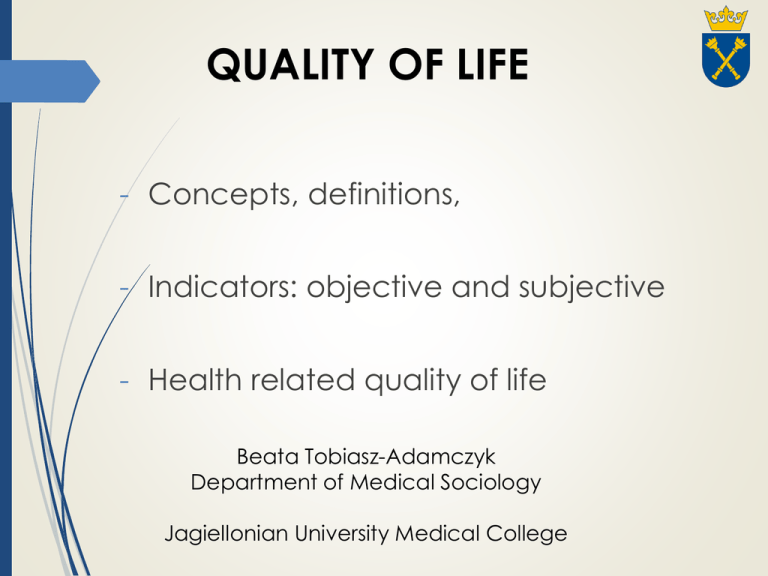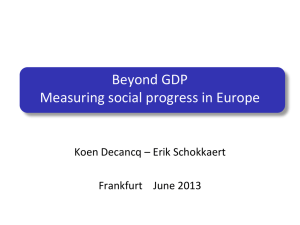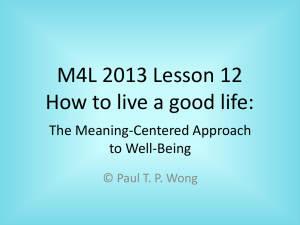Quality of life
advertisement

QUALITY OF LIFE - Concepts, definitions, - Indicators: objective and subjective - Health related quality of life Beata Tobiasz-Adamczyk Department of Medical Sociology Jagiellonian University Medical College • Abrams (1973) – quality of life as the degree of satisfaction or dissatisfaction felt by people with various aspects of their lives. • Andrews (1974) -the extent to which pleasure and satisfaction characterize human existence. • Dalkey and Rurke (1973)- a person’s sense of well-being ,his satisfaction or dissatisfaction with life, or his happiness or unhappiness. • Campell (1976) Andrew and Withey, 1976, Hanestad (1990)-quality of life concerns the individual person’s experience of his/her own life and life situation ,with quality of life reflecting the individual’s well-being. Shin & Johnson (1978) self-evaluation through comparison-The possession of resources necessary to the satisfaction of individual needs, wants and desires, participation in activities enabling personal development and self actualization and satisfactory comparison between oneself and others. Mendola & Pellegrini (1979) quality of life – the individual’s achievement of satisfactory social situation within the limits of perceived physical capacity. George & Bearon (1980) quality of life in terms of four dimensions – two objective (general health and functional status and socioeconomic status) and two subjective (personal judgement of the individual) subjective evaluation of life satisfaction and self-esteem. Clark & Bowling (1989) quality of life – not limited to functional ability, level of activity, mental state, and longevity, but encompasses the concepts of privacy, freedom, respect for the individual, freedom of choice, emotional well-being and maintenance of dignity. Micro-economic definition of quality of life. (Gillingham and Reece,1979) – quality of life for individual is the level of satisfaction he achieves as a result of his consumption of market goods, leisure, public goods ,and other physical and social characteristics of the environment in which he is located. Holmes & Dickerson (1987) – as an abstract and complex term representing individual responses to the physical, mental and social factors which contribute to „normal” daily living. Dimensions of quality of life most frequently mentioned by older people: family, children, social contacts, health, mobility/ability, material circumstances, activities, youthfulness, home environment. happiness, Campell (1972) quality of life in terms of subjective well-being – satisfaction and happiness. Objective indicators :living conditions (favourable or unfavourable) by comparing real conditions with normative criteria like value, goals or objectives. Objective indicators: level of unemployment, crime, average income or educational level, age of retirement. Scandinavian welfare researches – welfare measurement exclusively on objective indicators Welfare is understood as the „individuals command over, under given determinants mobilizable resources, with whose help her/him can control and consciously direct his/her living conditions” (Erikson,1974, Erikson 1993) Perception of the individual citizen „as an active , creative being, and autonomous definer of his own end. Resources: money, property, knowledge, psychic and physical energy, social relations, security” (Erikson/Uunisitalo,1987) Amartya Sen (the Nobel Price in Economy) „Living as a combination of various” doing and being with quality of life to be assessed in terms of the capability to achieve valuable functionings” (Sen,1993). Functionings “represent part s of the state of a person- in particular the various things that he or she manages to do or be in leading a life (functioning – being adequately nourished, being in good health, achieving self-respect or being socially integrated)” . Quality of life Encompasses the entire range of human experience, states, perceptions, and spheres of thought concerning the life of an individual or a community. Both objective and subjective, quality of life can include cultural, physical, psychological, interpersonal, spiritual, financial, political, temporal, and philosophical dimensions. Quality of life implies a judgment of value placed on the experience of communities, groups such as families, or individuals(D.L. Patrick, P. Erickson, 1993) I. Gross Domestic Product (GDP). II. Easterlin (1974) first identified the 'Easterlin Paradox' whereby average national happiness does not appear to increase over long spans of time, in spite of large increases in per capita income. Since then many studies have examined the relationship between national income and measures of subjective well-being. Sacks, Stephenson and Wolfers (2010) presented an alternative interpretation of income and satisfaction data. They argued that absolute income plays an important role in influencing well-being and that those countries experiencing more rapid economic growth also tend to experience more rapid growth in life satisfaction. III. Main Iimitations of GDP as an indicator of weIIbeing excludes determinants of well-being outside the production boundary e.g. household production, leisure, externalities, quality of social relations, health and longevity, good institutions includes economic activities that either reduce well-being or that remedy the costs of economic growth. Crime, war, pollution, and car accidents all cause people to spend money - and so they all increase the GDP but it is arguable whether or not these increase wellbeing imperfectly measures the impact on well- being of some activities inside the production boundary e.g. the output of public services does not inform on whether well-being can last over time Lane (1996) quality of life not only state but as a process which includes subjective and objective elements active role of personal experience and the capacity of individuals - quality of persons as a constitutive element of quality of life. Cobb (2000) needs-based approach – quality of life involves the satisfaction of the desires of individuals and the good society is defined as one that provides the maximum satisfaction or positive experiences for its citizens Quality of society-living conditions and quality of life in a society: family life, the health situation, education or poverty and on social groups like the elderly, young people, women, children. Life Satisfaction Indicators: subjective well-being, happiness – psychological satisfaction, happiness and fulfillment .Approach based on the belief that direct monitoring of key socio-psychological states necessary for an understanding of social change and the quality of life. Quality of Life Index (Ed Diener, 1995) The Basic QOL Index and Advanced QOL Index for developed countries. The basic QOL Index includes several variables: purchasing power, homicide rate, fulfillment of basic needs, suicide rate, literacy rate, gross human rights violation, and deforestation. The advanced QOL Index includes several variables: physicians per capita, savings rate, per capita income, subjective well-being, college enrollment rate, income inequalities and environmental treaties signed. Ed Diener, Eunkook Suh (1997) Three major philosophical approaches to determining the quality of life (Brock, 1993): 1. Characteristics of the good life that are dictated by normative ideals based on religious, philosophical or other systems (helping others), Kant believed that judgment about the correctness of behaviors and the good life , come from rational thought. 2. Good life based on the satisfaction and preferences (citizen can obtain the things they desire). Good life based on people’s choices. 3. Quality of life in terms of the experiences of individuals: feelings of enjoy, pleasure, contentment and life satisfaction. This approach is mostly subjective well-being associated with the Objective „social indicators” and subjective „well-being” - well-being can be defined individuals’ subjective experiences with their life – conscious experiences – hedonistic feelings or cognitive satisfaction (how people feel about life in context of his or her own standards). Objective – social indicators: Objective circumstances in a given cultural or geographical unit (infant mortality, doctors per capita, rates of rape, longevity, homicide rats, police per capita, ecology, human rights, welfare, education). Wealth and others social indicators Objective quality of life indicators must… be quantifiable not reflect the values of a specific culture be measurable internationally be easy to understand and simple to construct the improvements of the Good Life Index over existing indices are the following: 1. Happiness and life satisfaction are used as criteria of QOL. 2. Education is not included because, unlike material well-being and health, it is not necessarily correlated with life satisfaction. 3. Per capita GDP is not used as an indicator of material well-being. Instead, the Good Life Index uses household income. 4. GLI uses only three indicators. This makes it simple to construct and interpret. Subjective well-being consists of three interrelated components: life satisfaction, pleasant affect and unpleasant affect (pleasant and unpleasant mood and emotions, life satisfaction refers to a cognitive sense of satisfaction with life) domains associated with work and leisure., based on internal judgment of well-being. Small correlation between subjective indicators. objective and The central elements of well-being, a sense of satisfaction with one’s life and positive affective experiences - in context of one’s most important values and goals. A model of quality of life Individual and societal quality of life indicators 1. Objective characteristics unemployment. such as 2. The person’s recall of positive versus negative life-events. 3. Assessments of the person’s happiness by friends and family members. 4. Assessments of the person’s happiness by his or her spouse. 5. Duration of authentic or so-called Duchenne smiles (a Duchenne smile occurs when both the zygomatic major and obicularus orus facial muscles fire, and human beings identify these as ‘genuine’ smiles). 6. Heart rate and blood-pressure measures responses to stress, and psychosomatic illnesses such as digestive disorders and headaches. 7. Skin-resistance measures of response to stress. 8. Electroencephelogram measures of prefrontal brain activity. Self-reported measures are recognized to be a reflection of at least four factors: circumstances, aspirations, comparisons with others, and a person’s baseline happiness or dispositional outlook (e.g. Warr, 1980; Chen and Spector, 1991). Konow and Earley (1999) describe evidence that recorded happiness levels have been demonstrated to be correlated with the following. Definition of happiness is the degree to which an individual judges the overall quality of his or her life as favorable (Veenhoven, 1991, 1993). Psychologists draw a distinction between the well-being from life as a whole and the wellbeing associated with a single area of life: these they term ‘context-free’ and ‘contextspecific’. Social well-being is also a key component of health-related quality of life, in relation to the availability of practical and emotional support that is perceived by the individual to be satisfying. Health-related quality of life is a major concept in both sociological and psychological research in relation to the experiences of illness and the outcome of health services. It is multifaceted and encompasses physical, psychological and social domains of health. Health related quality of life is the value assigned to duration of life as modified by the impairments, functional states, perceptions and social opportunities that are influenced by disease, injury, treatment or policy. Quality of life was defined, therefore, as individuals’ perception of their position in life in the context of the culture and value systems in which they live and in relation to their goals, expectations, standards and concerns. Quality of life as the degree of satisfaction or dissatisfaction felt by people with various aspects of their lives. Four underlying dimensions to the concept, two of which are objective and two of which reflect the personal judgement of the individual; general health and functional status; socioeconomic status; life satisfaction and selfesteem. Positive aging—feelings of control, social relationships, quality of environmental settings (Day 1991), mental health, cognitive efficacy, social competence and productivity, personal control, life satisfaction Positive health-ability to cope with stressful situations, the maintenance of a strong social support system, integration in the community, high morale and life satisfaction, psychological wellbeing and level physical fitness and physical health. Health (functional ability) role functioning (domestic), quality of social and community interaction, psychological well-being, somatic sensations (pain), life satisfaction. Quality of life: possession of resources necessary to the satisfaction of individual needs, wants, and desires; participation in activities enabling personal development and self- actualization and satisfactory comparison between oneself and others. Current usage of health status implies a multifaceted concept, it overlaps with the broader concept of health-related quality of life. Both can encompass physical health (e.g. fitness, symptoms, signs of disease and wellness), physical functioning (ability to perform daily activities and physical roles), social functioning and social health (relationships, social support and activities), psychological well-being (depression, anxiety), emotional well-being (life satisfaction, morale, control, adjustment) and perceptions. coping and The concepts of perceived health status, quality of life and health-related quality of life can be complex to analyse as they might be mediated by several interrelated variables, including selfrelated constructs (e.g. self-efficacy, self-esteem, perceived control over life) and subjective evaluations could be influenced, in theory, by cognitive mechanisms (e.g. expectations of life, level of optimism or pessimism, social and cultural values, aspirations, standards for social comparisons of one’s circumstances in life). A wide range of domains of health-related quality of life, including emotional well-being (e.g. measured with indicators of life satisfaction and self-esteem), psychological well-being (e.g. measured with indicators of anxiety and depression), physical well-being (e.g. measured with measures of physical health status and physical functioning) and social well-being (e.g. measured with indicators of social network structure and support, community integration, functioning in social roles). Psychological concept: Distinguished between positive and negative affect and defined happiness as the balance between the two. Sociological concept: Life satisfaction – key indicator of well-being. Well-being – overall life satisfaction and specific domains: work, relationships neighborhood. income, social Philosophical approaches GOOD LIFE 1.The hedonist, which takes the ultimate good for people to underlie certain conscious experiences, 2. Preference satisfaction, which defines the good life as the satisfaction of people’s desires or preferences, 3. The ideal, which holds that part of a good life consists of the realization of specific, normative ideals (Brock 1993; Scanlon 1993) Model of healthy aging Going and doing SOMETHING TO DO ATTITUDE adaptation support adaptation ABILITY supplement supplement support SOCIAL RESOURCES Source: Bryant LL., Corbett KK., Kutner Js., 2001 Quality of life •Physical (impaired function, pain) •Psychological (depression, anxiety, well-being) •Social (isolation, illness behaviors) •Life setting before disease onset •Acute illness (illness suddenly interrupts a person’s way of life) •Chronic illness and rehabilitation •Effects of medical treatment Quality of life dimensions PHYSICAL FUNCTIONAL EMOTIONAL SOCIAL Symptom s side effects Role performance Distress Sociability Wellbeing Intimacy WORK Activities of daily living SEXUALITY LEISURE SPIRITUALITY TRAETMENT SATISFACTION FAMILY FUNCTIONING Norway New gend equality index for municipalities The index was changed in 2009. Compared with the previous gender equality index, the new index has more indicators and has been compiled using a more composite method. The municipalities are rated according to a sliding scale from 0 (Ieast equality) to 1 (most equality) for each of the indicators, which is then input to an aggregate index (a weighted average). The indicators are as follows: 1. Institutional and structural frameworks for local equality 1.1. Governmental facilitating of potential equality - Share of children aged 1-5 years in kindergarten 1.2. Structure of industry and educational patterns - Share of employees in gender-balanced industries (one-digit level) - Ratio between women and men in the public sector - Ratio between women and men in the private sector - Share of pupils in upper secondary school in a gender-balanced education programme 2. Men's and women's local adaptations 2.1. Distribution of time, work/care - Ratio between the share of men and women in the labour force - Ratio between the share of men and women in part-time employment - Share of fathers taking statutory paternity leave or more (from parental leave in connection with childbirth) 2.2. Distribution of individual resources/influence - Ratio between the share of men and women with higher education - Share of female managers 2.3. Distribution of political influence - Share of women in the municipal council 2.4. Distribution of money - Ratio between men's and women's average gross income







